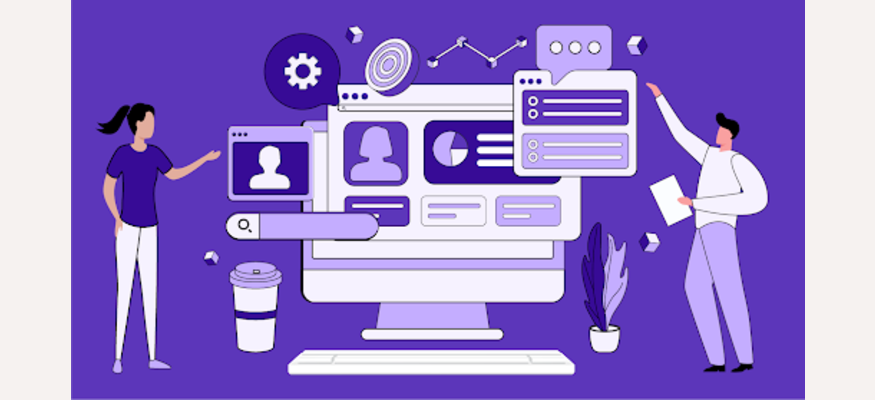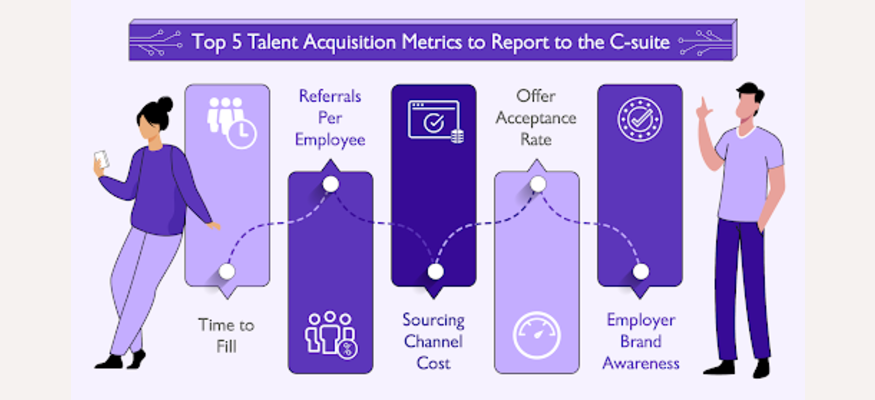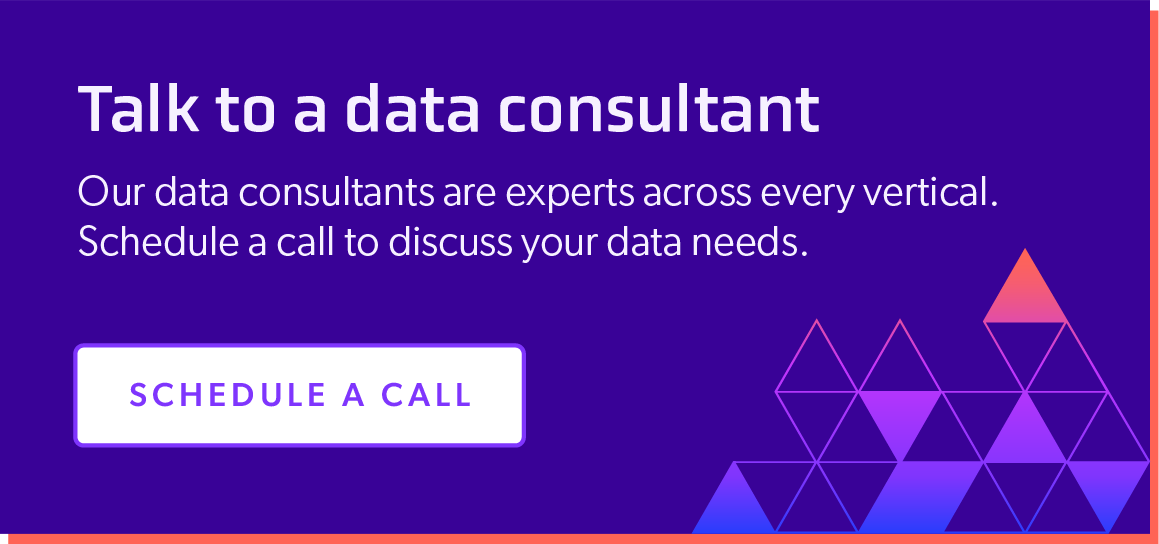
5 Most Crucial Talent Acquisition Metrics to Track for Your Business
January 20, 2022
Table Of Contents

According to the most recent Bureau of Labor Statistics data, 79 percent of job seekers take into account a company’s mission when entering the application process.
This fact reflects the overall shift in the makeup of the job market. Continuous improvement to become an employer of choice has become a higher priority than meeting short-term recruiting needs.
Today’s most successful companies incorporate various talent acquisition and recruiting metrics to measure their progress empirically.
With hundreds of metrics to choose from, you need to get your priorities straight. In this article, we’ve highlighted the five most crucial talent acquisition metrics to supercharge your HR functions.
Why Do Talent Acquisition Metrics Matter?
It’s hard to improve what you can’t measure. That’s why empiric talent acquisition metrics remove the guesswork for business leaders, empowering them to make better strategic decisions.
It’s essential to know that talent acquisition and recruitment, even though used interchangeably, approach optimizing the core HR functions in a conceptually different way.
While recruitment is merely a tool to fill a job opening, talent acquisition views a given organization from a strategic perspective, focusing on systemic changes that help the company stand out from the rest of the employers on the job market.
Read More: How to Utilize Data in the Recruitment Process to Find & Hire the Best Candidates
Top 5 Talent Acquisition Metrics to Report to the C-suite
With the rise of big data, organizations started collecting massive volumes of information about their candidates and employees, but that’s only one step on the path to utilizing data to streamline the recruitment process. What truly makes a difference is how you actually use and measure the data you collected.
It’s easy to get overwhelmed when you have hundreds of metrics to choose from - and when you let crucial KPIs slip through the cracks, you are more likely to make the wrong move.
This section aims to help you prioritize your efforts by zeroing in on the metrics that matter the most to any organization when it comes to talent acquisition efforts.
1. Time to Fill
Time to fill refers to the average number of days it takes an organization to fill its open positions. The metric captures the time from job requisition (formal permission to create a new role within an organization) to job acceptance (the moment when a qualified candidate accepts a job offer).
A short time to fill positively impacts the entire organization, meaning less overtime and fewer process disruptions for the rest of your workforce while you’re looking for a replacement.
Conversely, suppose it takes too long to find a replacement. In that case, that may indicate various issues in the recruiting process, from the structure of the offer, to how your HR specialists and hiring managers communicate with candidates.
Additionally, awareness of your time to fill improves strategic planning, helping you realistically evaluate the time it would take to replace a former employee.
There’s a significant overlap between time to hire and time to fill, which are, in fact, two separate talent acquisition metrics.
Time to fill measures the average time it took an organization to fill positions from their initial listing date, while time to hire measures the average time it took your organization to hire candidates from their initial application.
To boost this talent acquisition metric, compare time to fill for every department to identify areas of improvement, and optimize the hiring process without sacrificing the quality of your screening process.
2. Referrals Per Employee
82 percent of employers consistently place employee referrals above all other talent acquisition sources when it comes to the quality of hired candidates.
Measuring referrals per employee helps you evaluate the strength of their personal and professional network.
Employee referrals have certain advantages over other talent acquisition sources that make them incredibly valuable:
Reduced time to hire and time to fill as you don’t need to sift through hundreds of candidates before finding a good fit
Decreased hiring costs since you don’t need to spend money on third-party platforms and tools to source qualified candidates
Improved new hire quality since your employees understand how your company and culture works from within to form a good understanding of how they would fit into your teams
Boost your offer acceptance rate - employee referrals increase the chance of a positive job match, on average, by 2.6 to 6.6 percent, according to a study conducted by Glassdoor..
Lowered risk of a bad hire because great performers with impeccable work ethic tend to associate with people possessing the same traits, allowing you to build a close-knit team of high achievers
With all of the benefits employee referrals bring to the table, it’s crucial to analyze the performance of your employee referral program.
To improve this talent acquisition metric, offer competitive referral bonuses to incentivize employees and ensure high employee and hiring manager satisfaction levels - because money isn’t everything.
3. Sourcing Channel Cost
Sourcing channel cost measures the average amount of money required to acquire a candidate into your hiring pipeline via a certain sourcing channel.
Depending on your goals, you can measure sourcing channel cost per either candidate or hire.
Understanding this key talent acquisition metric is incredibly important as it allows you to:
Accurately identify best-performing sourcing recruiting channels
Optimize your talent acquisition costs
Better budget your talent acquisition campaigns
Understand what it actually takes to bring in a new employee from a financial standpoint
Measure the effectiveness of your HR professionals
With so many benefits, it’s essential to know how to utilize this metric the right way.
For instance, if you find out that you can spend just $1,000 to get a new hire with LinkedIn ads, and it was originally costing you $5,000 on Facebook, it makes sense to reallocate the funds you spent on Facebook ads to LinkedIn.
Additionally, suppose companies in your industry need to spend, on average, $3,000 on LinkedIn ads to achieve the same result. In that case, you can reward your recruiting team for significantly overperforming the benchmark.
To get the most out of this metric, it’s essential to take into account the hourly rate of your HR and marketing specialists. Free talent acquisition sources - such as job boards - might end up, surprisingly, costing you more when you factor that in.
4. Offer Acceptance Rate
Offer acceptance rate is the percentage of candidates that have accepted your job offer within a specific timeframe.
Primarily, the metric helps measure if and how well your offer matches the expectations of your candidates.
Additionally, the offer acceptance rate empowers you to:
Understand the competitiveness of your job offer
Evaluate the robustness of your screening process
Analyze the quality of your communication with your candidates
Assess the strength of your employer brand
Organizations usually calculate their annual offer acceptance rate, but you can tweak the timeframe to understand how good you are at securing qualified talent during various periods.
To improve your offer acceptance rate, incentivize candidates to leave their feedback regardless of the outcome - as it’s the fastest and easiest way to identify weak spots in your hiring process.
5. Employer Brand Awareness
Employer brand awareness refers to the reputation of a company as an employer in comparison to the rest of the market as well as the value it brings to its employees.
A solid employer brand is the secret sauce allowing established companies to consistently attract top talent and dominate the job market in their industry.
A negative reputation may end up costing your company roughly 10 percent more in hiring and ongoing costs per hire. In contrast, working on your employer brand brings the following benefits to your organization:
Consistently attract top talent
Reduce recruitment and training costs
Boost your employee retention rates
Reduce the time it takes to fill open positions
Increase the overall productivity of your workforce
Boost employee loyalty and morale
With so many substantial benefits, building a solid employer brand is the key part of any long-term talent acquisition strategy, as being an employer of choice makes you less susceptible to the competition and job market fluctuation.
Unfortunately, there’s no one-size-fits-all formula that you can use to calculate employer brand awareness, but some of the things you may want to add to the equation include:
Social media mentions
User engagement with the digital assets of an organization - be it the website or social media profiles
Mentions in major industry and mainstream media outlets
The number and volume of organic branded keyword terms in search engines
The average number of users visiting your website every month
To get started, measure the current performance of your employer brand using some or all of the KPIs mentioned above, and set benchmarks to start measuring the ROI of your efforts.
To improve your employer brand awareness, consider aligning your efforts with your marketing department to launch a digital PR campaign to promote your organization as an employer of choice.
This is not a fast process, but the payoff is tremendous once you start consistently investing in solidifying your employer brand.

Supercharge Your Talent Acquisition Strategy
The decline of recruiting and the rise of talent acquisition represents how companies changed the way they approach growing their teams.
But for talent acquisition to generate a high ROI, you need to rely on fresh, accurate, and high-quality candidate data.
People Data Labs offers talent acquisition solutions for organizations that are looking to supercharge their talent acquisition funnel. If you’re looking to get started, get in touch with our team today to schedule a free consultation.
Like what you read? Scroll down and subscribe to our newsletter to receive monthly updates with our latest content.




